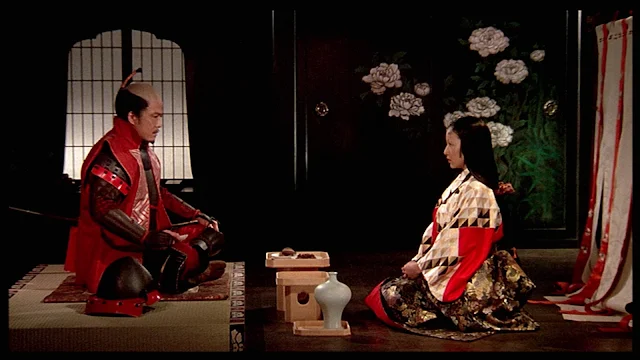 |
| Yoshiko Kuga and Yusuke Kawazu in The Eternal Rainbow |
Chie Obita: Yoshiko Kuga
Shiro Machimura: Takahiro Tamura
Kikuo Suda: Yusuke Kawazu
Fumi Kageyama: Kinuyo Tanaka
Naoji Kageyama: Chishu Ryu
Minoru Kageyama: Kazuya Kosaka
Kyoichiro Obita: Minoru Oki
Hiroko Sonobe: Hizuru Takachiho
Director: Keisuke Kinoshita
Screenplay: Keisuke Kinoshita
Cinematography: Hiroshi Kusuda
Art direction: Chiyoo Umeda
Film editing: Yoshi Sugihara
Music: Chuji Kinoshita
An unstable mixture of documentary and domestic melodrama, The Eternal Rainbow begins with shots of the Yawata steel mill complex and a voiceover narration telling us how steel is made and then wandering out into the surrounding industrial community, where the company has built recreation and cultural facilities for the workers as well as what the narrator calls "beautiful apartment buildings." (They're rather bleakly landscaped multistory boxes with stairwells open to the elements.) We're also told that the smoke that rises above the mill appears in five distinct colors, although I couldn't discern much beyond various shades of gray and yellow. Despite the idyllic tone of the documentary, the lives of the workers don't seem particularly blissful: There's some resentment and discrimination between the factory workers and the office workers, which extends to the romantic entanglements that form the plot of the "fictional" side of Keisuke Kinsoshita's film. The hazards of factory work are not overlooked, either. Twice we learn of accidents that send the steelworkers to the company hospital, though Kinoshita doesn't show either accident taking place. The second accident involves one of the principal characters, Suda, a handsome young worker whose job it is to ride on the front of the engine through the factory's railyards and leap off to run ahead and pull the switch. Suda rents a room from the Kageyamas, who have a son, Minoru, who never made the grade in strength or ability to work in the mill, and continually searches for a job. Naoji Kageyama is nearing retirement, and he and his wife will be forced to move out of the apartment they rent from the company. Suda also gets involved in pleading the case for his older friend Sagara, who is in love with the pretty Chie, who's not sure she wants to marry a steelworker; her parents want her to marry the engineer Machimura, who has just accepted a job with the company's Brazilian branch. These rather paltry domestic matters are not enough to carry the film by themselves, which may be why Kinoshita chose to insert them into the documentary. What interest the film has lies mainly in some impressive scenes inside the mill and in its environs, but it gets bogged down in scenes of the "Water Carnival" staged for the entertainment of the workers, consisting mainly of young women dancing to pop and light classical music in front of a band shell in the middle of a pond. There are too many characters to sort out for the fictional story to have much impact.









